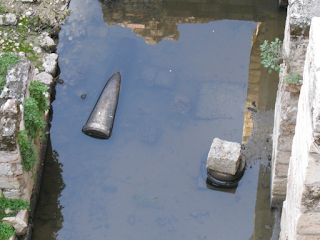< Walking on water | Index | No later items >
Nobody has ever done this before! Why? What happened? This rabbi with his disiples following along - he's healed a man that was born blind. He can see now, he really can see! Hmm... Sounds a bit far fetched to me. No, really, the Pharisees have checked with the guy's parents.
 |
| Remains of the Pool of Siloam |
John 9:1-41 begins with a question. The disciples would like to know why a man was born blind. Was it because of his own sins or those of his parents?
As he went along, he saw a man blind from birth. His disciples asked him, ‘Rabbi, who sinned, this man or his parents, that he was born blind?’
‘Neither this man nor his parents sinned,’ said Jesus, ‘but this happened so that the works of God might be displayed in him. As long as it is day, we must do the works of him who sent me. Night is coming, when no one can work. While I am in the world, I am the light of the world.’
After saying this, he spat on the ground, made some mud with the saliva, and put it on the man’s eyes. ‘Go,’ he told him, ‘wash in the Pool of Siloam’ (this word means ‘Sent’). So the man went and washed, and came home seeing.
His neighbours and those who had formerly seen him begging asked, ‘Isn’t this the same man who used to sit and beg?’ Some claimed that he was.
Others said, ‘No, he only looks like him.’
But he himself insisted, ‘I am the man.’
‘How then were your eyes opened?’ they asked. (more...)
Healings were by no means unknown in Jesus' day. But healing a man born blind was regarded as one of three 'Messianic miracles', one that only the Messiah would be able to do. To the religious authorities in Jerusalem it is therefore clear evidence that Jesus is, indeed, the Messiah. That's why the Pharisees wanted to check this inconvenient evidence very thoroughly.
Here are the four questions suggested by Neil Cole with some pointers for finding the answers in the material quoted above.
What does this story tell us about people? - Who was there? Well, the blind man himself of course. The disciples were there watching. We also hear about the man's neighbours and others who knew him. The Pharisees get involved and interview the man's parents. There's a lot going on and we see people with just the same attitudes and issues that we see in people today. Why do you think the Pharisees are so unwilling to accept that the man was healed?
What does it tell us about Jesus? - What did Jesus actually do? How did he heal the man? Why didn't he just say "Be healed"? Does he always do what we expect? Does he always wait for us to ask for something? (Did the blind man asked for his sight?)
What does it tell me about myself? - Are you more like the disciples, the man who was healed, the parents or the Pharisees? Maybe, in some ways, you are like them all. Who had faith in this story? How would you have reacted in the shoes of the people John describes? The blind man was obedient in what might have seemed a silly and pointless trip to Siloam. Are you obedient when you don't understand the reason?
Who else needs to hear this? - Who do you know who might benefit or be challenged or encouraged by hearing about this sign in John? Are you going to tell them?
Questions:
- How do you think the man felt when he washed at Siloam and began to see? [Tweet it!]
- Which triumphs in this passage, law or grace? How? Why?
See also:
- The three messianic miracles - Ariel ministries
< Walking on water | Index | No later items >






